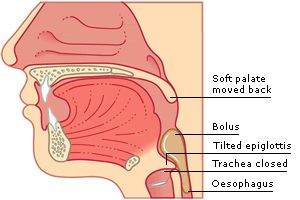Digestive system
The digestive system allows the body
to obtain nutrients and the energy necessary that it needs from what you eat; and
transform food and liquids into the fuel for the body.
The Mouth
The process begins when you take the
food into the mouth and forms saliva.
The saliva initiates the process of
descomposition of chemical substances that contain the food and help to soften
them so that it could be easier to swallow them.
The tongue helps you by pushing food
through your mouth while you chew with your teeth.
When you are ready to swallow, the
tongue pushes the food towards the back of the throat, so that it enters
through the oesophagus. This mixture is called bolus.
Oesophagus
The oesophagus is an elastic tube
that measures about 25 cm long. Conducts food from the back of the throat to
the stomach. The bolus passes down the pharynx.
In the back of the throat is also the trachea, which allows the air to enter and leave your body.
When you swallow the crushed food, the epiglottis closes the trachea so that the food enters the oesophagus and not into the trachea.
The muscles of the oesophagus make a wavering movement to crush the food when it descends.
Stomach
The stomach is attached to the
esophagus. It is an elastic "sack" and has the following functions:
- Store the food.
- Secretes substances called gastric
juices. Gastric juices descompose food and form a paste called chyme, they
destroy germs and bacteria in food.
- Empty that liquid to the small
intestine
Small intestine
The small intestine is a long tube
folded under the stomach.
The small intestine descomposes more
the food, so that the body absorbs the nutrients.
The pancreas, liver and gallbladder
send juices to the small intestine to digest food.
The food products that your body can
not use will go to the large intestine.
Liver
The blood with the nutrients goes to
the liver. The liver filters the blood and transforms noxious substances in
bile. The liver distributes the nutrients for the body and the reserve
nutrients.
Large intestine
The large intestine is thicker than the
small intestine and is folded. It has a small tube called appendix.
The appendix does not have any function, but it can become infected and it has
to be extirpate.
The water and the last minerals are
absorbed in the colon. When waste products do not have water they become solid:
they are faeces.
The large intestine pushes the feces
to the rectum, the last part of the digestive tube to go to the bathroom and
are expelled through the anus.
Systems related with the digestive
system
- With the circulatory
system. The digestive system carries nutrients to the circulatory system and
the circulatory system carries the molecules to every part of the body.
- With the
nervous system. The nervous system controls the contraction of the muscles of
the digestive system.
- With the
excretory system, it expels waste substances.












No hay comentarios:
Publicar un comentario